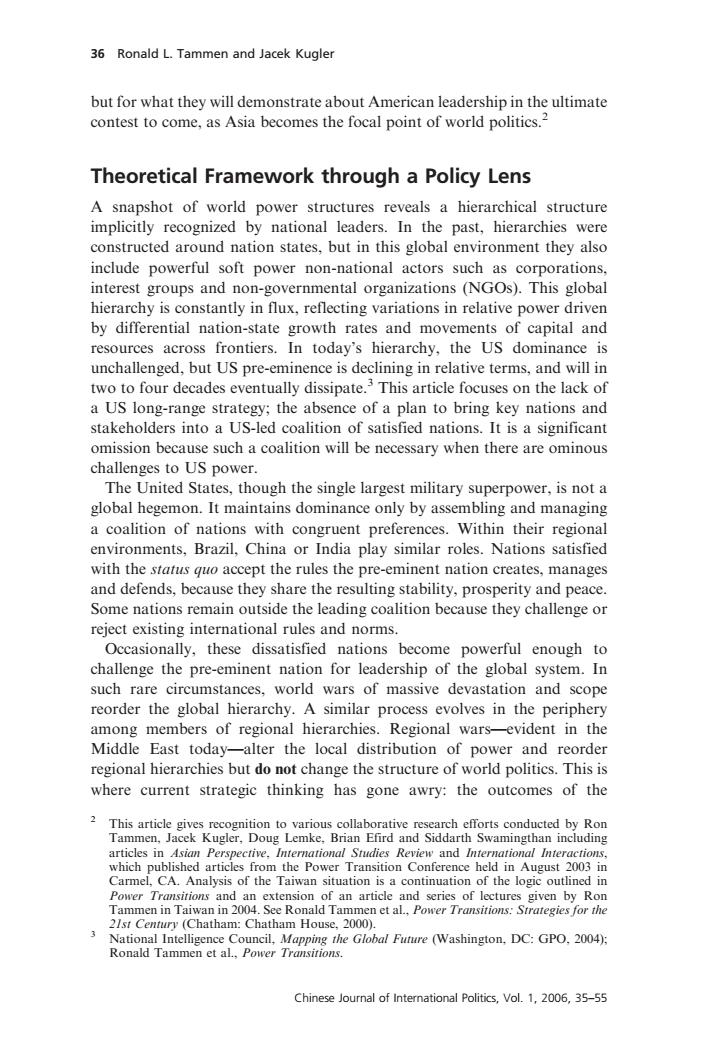正在加载图片...

36 Ronald L.Tammen and Jacek Kugler but for what they will demonstrate about American leadership in the ultimate contest to come,as Asia becomes the focal point of world politics.2 Theoretical Framework through a Policy Lens A snapshot of world power structures reveals a hierarchical structure implicitly recognized by national leaders.In the past,hierarchies were constructed around nation states,but in this global environment they also include powerful soft power non-national actors such as corporations, interest groups and non-governmental organizations (NGOs).This global hierarchy is constantly in flux,reflecting variations in relative power driven by differential nation-state growth rates and movements of capital and resources across frontiers.In today's hierarchy,the US dominance is unchallenged,but US pre-eminence is declining in relative terms,and will in two to four decades eventually dissipate.'This article focuses on the lack of a US long-range strategy;the absence of a plan to bring key nations and stakeholders into a US-led coalition of satisfied nations.It is a significant omission because such a coalition will be necessary when there are ominous challenges to US power. The United States,though the single largest military superpower,is not a global hegemon.It maintains dominance only by assembling and managing a coalition of nations with congruent preferences.Within their regional environments,Brazil,China or India play similar roles.Nations satisfied with the status quo accept the rules the pre-eminent nation creates,manages and defends,because they share the resulting stability,prosperity and peace. Some nations remain outside the leading coalition because they challenge or reject existing international rules and norms. Occasionally,these dissatisfied nations become powerful enough to challenge the pre-eminent nation for leadership of the global system.In such rare circumstances,world wars of massive devastation and scope reorder the global hierarchy.A similar process evolves in the periphery among members of regional hierarchies.Regional wars-evident in the Middle East today-alter the local distribution of power and reorder regional hierarchies but do not change the structure of world politics.This is where current strategic thinking has gone awry:the outcomes of the 2 This article gives recognition to various collaborative research efforts conducted by Ron Tammen,Jacek Kugler,Doug Lemke,Brian Efird and Siddarth Swamingthan including articles in Asian Perspective,International Studies Review and International Interactions, which published articles from the Power Transition Conference held in August 2003 in Carmel,CA.Analysis of the Taiwan situation is a continuation of the logic outlined in Power Transitions and an extension of an article and series of lectures given by Ron Tammen in Taiwan in 2004.See Ronald Tammen et al.,Power Transitions:Strategies for the 2/st Century (Chatham:Chatham House,2000). National Intelligence Council,Mapping the Global Future (Washington,DC:GPO,2004); Ronald Tammen et al.,Power Transitions. Chinese Journal of International Politics,Vol.1,2006,35-55but for what they will demonstrate about American leadership in the ultimate contest to come, as Asia becomes the focal point of world politics.2 Theoretical Framework through a Policy Lens A snapshot of world power structures reveals a hierarchical structure implicitly recognized by national leaders. In the past, hierarchies were constructed around nation states, but in this global environment they also include powerful soft power non-national actors such as corporations, interest groups and non-governmental organizations (NGOs). This global hierarchy is constantly in flux, reflecting variations in relative power driven by differential nation-state growth rates and movements of capital and resources across frontiers. In today’s hierarchy, the US dominance is unchallenged, but US pre-eminence is declining in relative terms, and will in two to four decades eventually dissipate.3 This article focuses on the lack of a US long-range strategy; the absence of a plan to bring key nations and stakeholders into a US-led coalition of satisfied nations. It is a significant omission because such a coalition will be necessary when there are ominous challenges to US power. The United States, though the single largest military superpower, is not a global hegemon. It maintains dominance only by assembling and managing a coalition of nations with congruent preferences. Within their regional environments, Brazil, China or India play similar roles. Nations satisfied with the status quo accept the rules the pre-eminent nation creates, manages and defends, because they share the resulting stability, prosperity and peace. Some nations remain outside the leading coalition because they challenge or reject existing international rules and norms. Occasionally, these dissatisfied nations become powerful enough to challenge the pre-eminent nation for leadership of the global system. In such rare circumstances, world wars of massive devastation and scope reorder the global hierarchy. A similar process evolves in the periphery among members of regional hierarchies. Regional wars—evident in the Middle East today—alter the local distribution of power and reorder regional hierarchies but do not change the structure of world politics. This is where current strategic thinking has gone awry: the outcomes of the 2 This article gives recognition to various collaborative research efforts conducted by Ron Tammen, Jacek Kugler, Doug Lemke, Brian Efird and Siddarth Swamingthan including articles in Asian Perspective, International Studies Review and International Interactions, which published articles from the Power Transition Conference held in August 2003 in Carmel, CA. Analysis of the Taiwan situation is a continuation of the logic outlined in Power Transitions and an extension of an article and series of lectures given by Ron Tammen in Taiwan in 2004. See Ronald Tammen et al., Power Transitions: Strategies for the 21st Century (Chatham: Chatham House, 2000). 3 National Intelligence Council, Mapping the Global Future (Washington, DC: GPO, 2004); Ronald Tammen et al., Power Transitions. 36 Ronald L. Tammen and Jacek Kugler Chinese Journal of International Politics, Vol. 1, 2006, 35–55